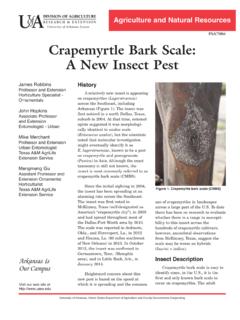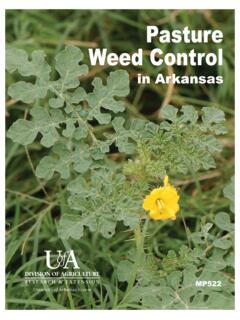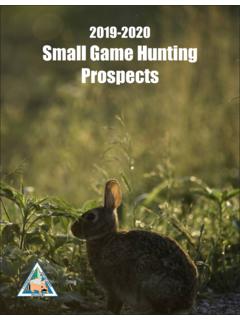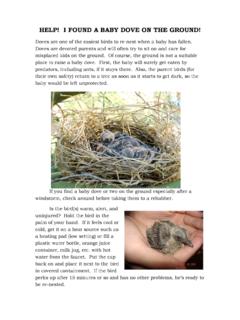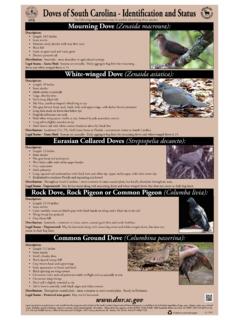Transcription of Sunflowers Grown for Dove Hunting - FSA-2150 - uaex.edu
1 Thomas R. ButtsAssistant Professor,Extension Weed Scientist Robert C. Scott Director, Rice Research and Extension CenterTrenton L. RobertsAssociate Professor, Soil FertilityTravis FaskeAssociate Professor, Extension Plant Pathologist Gus Lorenz Professor, Extension EntomologistBen C. ThrashAssistant Professor, Extension EntomologistNick R. Bateman Assistant Professor, Extension EntomologistArkansas IsOur CampusVisit our website at: is a crop that has limited commercial production in Arkansas. Potential markets are limited, and farm-to-market transportation may be cost prohibitive. Most producers in Arkansas are marketing seed locally as birdseed or growing Sunflowers for dove Hunting (Figure 1).
2 Sunflowers Grown for dove Hunting can be a recreational and profitable undertaking when fields are leased for guided dove Hunting ventures. Proper planning and the implementation of best management practices will enhance sunflower production. Key considerations for growing Sunflowers for dove Hunting include variety selection, planting date, fertilization, and weed control. Suitable Soils and Site PreparationSunflower production is best suited on well to moderately-drained sandy and silt loam soils, but Sunflowers can be Grown on a variety of soil textures. Field drainage is a primary concern when selecting a suitable site as Sunflowers are easily damaged by prolonged waterlogged conditions.
3 Therefore, poorly drained soils that are prone to flooding or experience prolonged waterlogging following precipitation events should be avoided. sunflower can be produced on heavy-textured clay loam soils with adequate drainage, and these soils can be advan-tageous during droughty years with lower than average summer precipi-tation. In fields with heavier textured soils or fields with poor drainage, implementing a bedded production system similar to furrow-irrigated row crops may facilitate adequate drainage and allow both wide and narrow row production options. Establishment of sunflower can be successful using both conventional and no-till planting practices.
4 With con-ventional tillage the seedbed should be firm with adequate moisture for rapid germination. Field preparation using con-ventional tillage equipment may include disking and rolling prior to planting. If seedbed firming (roller or bedder-roller) is not available or used, it is best to com-plete tillage operations at least 2 weeks prior to sunflower planting to allow the soil to settle and provide a good, firm seed bed for adequate seed-to-soil contact and germination. In no-till production systems a burndown herbicide may be applied 2 to 4 weeks prior to planting depending on weed pressure and growth. Planting DateSunflowers can be planted from late March to early July, with the optimum Sunflowers Grown forDove HuntingUniversity of Arkansas, United States Department of Agriculture, and County Governments CooperatingFigure 1.
5 Doves attracted to a sunflower field. (Courtesy of T9E Ranch, ).FSA2150 Agriculture and Natural ResourcesDIVISION OF AGRICULTURERESEARCH & EXTENSIONU niversity of Arkansas Systemdate being from mid-April to mid-May. Planting date sunflower seed per pound varies considerably, depending should be based on relative maturity of the variety upon the variety and seed size. The seed size is identified selected and considering that seed maturity should coin-on the bag. The seed bag information will indicate the cide with desired Hunting window. For a 100-120 day planter plates and setting needed to get a desired planting sunflower , a mid-April planting date will mature near rate.
6 The plant population with non-oil types (confection-mid-August providing 2-3 weeks for field preparation ary and birdseed) can be reduced to between 12,000 and prior to opening day. Soil temperature should be at least 18,000 plants per acre. A larger seedhead and increased 50 F for planting. sunflower germination requires a soil seed size are promoted by reducing plant population. Plant temperature near 55 F with a soil temperature at or population per acre should remain the same regardless above 65 F being ideal. Extended periods of soil tem-of row spacing. The seed spacing must be proportionately peratures below 50 F will delay germination and extend decreased with lower-germinating seed, but the number of the period of susceptibility to seedling diseases.
7 When seeds per foot of row is increased. A good rule of thumb to growing Sunflowers for dove, early planting dates help use for adjusting seeding rates is to allow for 90 percent ensure that Sunflowers are mature for the opening week-germination and 90 percent seedling survival. Additionally, end of dove season. Care should be taken to follow current if possible, planting in the north-south direction will regulations available from the Arkansas Game and Fish provide sunflower seedheads more space as they track Commission concerning baiting and crop manipulation. the sun. This can help reduce seedhead contact and early These regulations can change from year to year.
8 Seed shattering. Achieving the proper seeding rate with broadcast seeding is difficult and oftentimes broadcast sunflower Varieties seeding will result in stands that are too dense leading and Other Planting Detailsto increased drought potential, smaller seedheads, smaller seed and overall poor performance. Sunflowers are not typically bred for production in southern states. However, most varieties carried by the Fertilization local seed dealer or co-op will suffice for dove Hunting . Fertilization for sunflower production should follow soil A black oilseed type variety is typically preferred for its test recommendations for phosphorus (P) and potassium good production and earliness characteristics.
9 (K). Although there is no current crop code for sunflower production, using the current crop code for wildlife food Sunflowers should be planted 1 to 2 inches deep in moist plots with legumes (Crop Code 118) will provide adequate soil. It is not advisable to plant more than 3 inches deep P, K, and potential lime needs but some adjustments will since many of the newer hybrids have a short hypocotyl need to be made for nitrogen (N). Boron (B) is also a critical that cannot emerge from deep for sunflower production and may benefit from B applications to sandy or silt loam soils with high Sunflowers may be rotary hoed to aid emergence should pH and a history of B deficiency.
10 Generally, soils with soil crust from compacting rains. Best results are with moderate to low levels of P and K will need nitrogen, row- or drill-seeded Sunflowers ; however, broadcast phosphorus and potassium (NPK) at a rate of 60, 30 and incorporation is used by many growers, especially sports-60 pounds per acre, respectively. These nutrients can be men. Care should be taken to cover seed with at least 1 applied preplant incorporated, but sidedress applications inch of soil to provide sunflower the best opportunity for of N in-season when the plants are at least 8 inches tall emergence and establishment. The likelihood of success can enhance production and performance.






